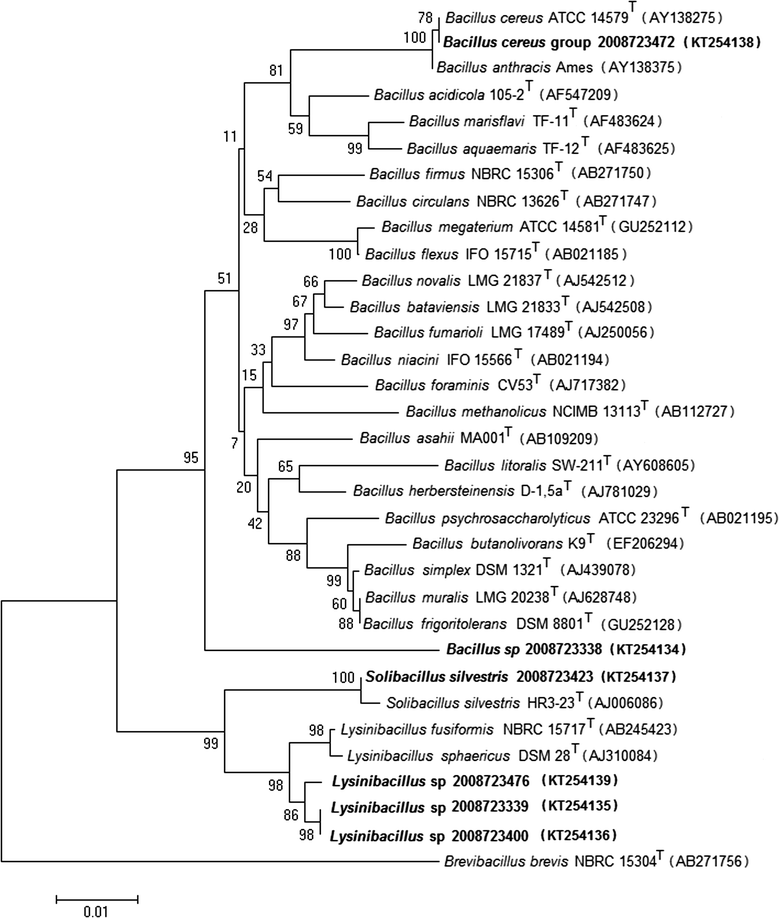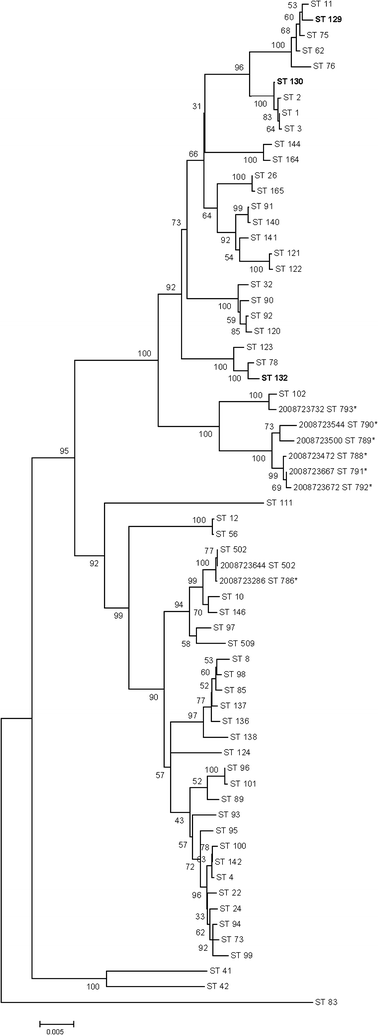Bacillus anthracis gamma phage lysis among soil bacteria: an update on test specificity
- PMID: 29145870
- PMCID: PMC5691394
- DOI: 10.1186/s13104-017-2919-8
Bacillus anthracis gamma phage lysis among soil bacteria: an update on test specificity
Abstract
Background: Bacillus anthracis, which causes anthrax in humans and animals, is enzootic in parts of the U.S. state of Texas where cases are typically reported in animals annually. The gamma phage lysis assay is a common diagnostic method for identification of B. anthracis and is based on the bacterium's susceptibility to lysis. This test has been shown to be 97% specific for B. anthracis, as a small number of strains of other Bacillus spp. are known to be susceptible. In this study, we evaluated the performance of a combination of B. anthracis diagnostic assays on 700 aerobic, spore-forming isolates recovered from soil collected in Texas. These assays include phenotypic descriptions, gamma phage susceptibility, and real-time polymerase chain reaction specific for B. anthracis. Gamma phage-susceptible isolates were also tested using cell wall and capsule direct fluorescent-antibody assays specific for B. anthracis. Gamma phage-susceptible isolates that were ruled out as B. anthracis were identified by 16S rRNA gene sequencing.
Findings: We identified 29 gamma phage-susceptible isolates. One was confirmed as B. anthracis, while the other 28 isolates were ruled out for B. anthracis by the other diagnostic tests. Using 16S rRNA gene sequencing results, we identified these isolates as members of the B. cereus group, Bacillus sp. (not within B. cereus group), Lysinibacillus spp., and Solibacillus silvestris. Based on these results, we report a specificity of 96% for gamma phage lysis as a diagnostic test for B. anthracis, and identified susceptible isolates outside the Bacillus genus.
Conclusions: In this study we found gamma phage susceptibility to be consistent with previously reported results. However, we identified non-B. anthracis environmental isolates (including isolates from genera other than Bacillus) that are susceptible to gamma phage lysis. To date, susceptibility to gamma phage lysis has not been reported in genera other than Bacillus. Though these isolates are not of clinical origin, description of unexpected positives is important, especially as new diagnostic assays for B. anthracis are being developed based on gamma phage lysis or gamma phage proteins.
Keywords: Anthrax; Bacillus anthracis; Gamma phage.
Figures


Similar articles
-
Molecular approaches to identify and differentiate Bacillus anthracis from phenotypically similar Bacillus species isolates.BMC Microbiol. 2006 Mar 3;6:22. doi: 10.1186/1471-2180-6-22. BMC Microbiol. 2006. PMID: 16515693 Free PMC article.
-
Polyphasic characterization of Bacillus species from anthrax outbreaks in animals from South Africa and Lesotho.J Infect Dev Ctries. 2016 Aug 31;10(8):814-23. doi: 10.3855/jidc.7798. J Infect Dev Ctries. 2016. PMID: 27580326
-
Characterization of Bacillus anthracis-like bacteria isolated from wild great apes from Cote d'Ivoire and Cameroon.J Bacteriol. 2006 Aug;188(15):5333-44. doi: 10.1128/JB.00303-06. J Bacteriol. 2006. PMID: 16855222 Free PMC article.
-
Characterization and comparative genomic analysis of bacteriophages infecting members of the Bacillus cereus group.Arch Virol. 2014 May;159(5):871-84. doi: 10.1007/s00705-013-1920-3. Epub 2013 Nov 22. Arch Virol. 2014. PMID: 24264384 Review.
-
Lysins as a powerful alternative to combat Bacillus anthracis.Appl Microbiol Biotechnol. 2024 Jun 8;108(1):366. doi: 10.1007/s00253-024-13194-3. Appl Microbiol Biotechnol. 2024. PMID: 38850320 Free PMC article. Review.
Cited by
-
Anthrax: A narrative review.New Microbes New Infect. 2024 Oct 10;62:101501. doi: 10.1016/j.nmni.2024.101501. eCollection 2024 Dec. New Microbes New Infect. 2024. PMID: 39497912 Free PMC article. Review.
-
Bacteriophage-based bioassays: an expected paradigm shift in microbial diagnostics.Future Microbiol. 2024 Jun 12;19(9):811-824. doi: 10.2217/fmb-2023-0246. Epub 2024 Jun 20. Future Microbiol. 2024. PMID: 38900594 Free PMC article. Review.
-
Enzyme-Linked Phage Receptor Binding Protein Assays (ELPRA) Enable Identification of Bacillus anthracis Colonies.Viruses. 2021 Jul 27;13(8):1462. doi: 10.3390/v13081462. Viruses. 2021. PMID: 34452328 Free PMC article.
-
Rapid Microscopic Detection of Bacillus anthracis by Fluorescent Receptor Binding Proteins of Bacteriophages.Microorganisms. 2020 Jun 21;8(6):934. doi: 10.3390/microorganisms8060934. Microorganisms. 2020. PMID: 32575866 Free PMC article.
-
Detection and Identification of Bacillus anthracis: From Conventional to Molecular Microbiology Methods.Microorganisms. 2020 Jan 16;8(1):125. doi: 10.3390/microorganisms8010125. Microorganisms. 2020. PMID: 31963339 Free PMC article. Review.
References
-
- Blackburn JK, McNyset KM, Curtis A, Hugh-Jones ME. Modeling the geographic distribution of Bacillus anthracis, the causative agent of anthrax disease, for the contiguous United States using predictive ecological niche modeling. Am J Trop Med Hyg. 2007;77:1103–1110. - PubMed
-
- Mullins JC, Van Ert M, Hadfield T, Nikolich MP, Hugh-Jones ME, Blackburn JK. Spatio-temporal patterns of an anthrax outbreak in white-tailed deer, Odocoileus virginanus, and associated genetic diversity of Bacillus anthracis. BMC Ecol. 2015;15:23. doi: 10.1186/s12898-015-0054-8. - DOI - PMC - PubMed
-
- CDC Human anthrax associated with an epizootic among livestock—North Dakota, 2000. MMWR Morb Mortal Wkly Rep. 2001;50:677–680. - PubMed
Publication types
MeSH terms
LinkOut - more resources
Full Text Sources
Other Literature Sources
Miscellaneous

